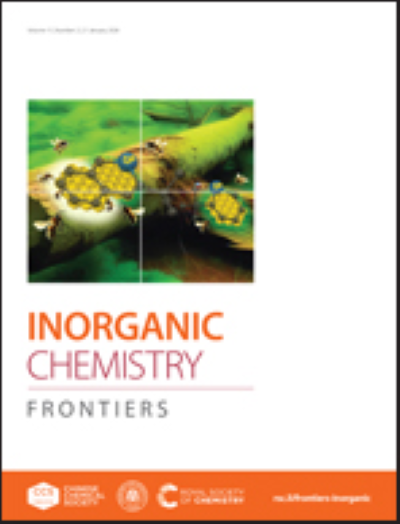通过晶域工程增强HCP-Ru催化剂的边缘化学,实现高效的碱性析氢
IF 6.1
1区 化学
Q1 CHEMISTRY, INORGANIC & NUCLEAR
引用次数: 0
摘要
设计过渡金属催化剂的纳米级结构为通过调整表面配位和电子态来提高其固有活性提供了一条有前途的途径。在这里,我们报道了一种MgO辅助溶剂热策略,用于在异丙醇中从Ru(acac)3合成六方密装(HCP) Ru纳米球,其中MgO模板调节结晶途径,优先暴露(100)和(002)面,同时抑制(101)面。这种面选择性生长导致形成明确的晶体域,具有丰富的低配位边缘位点和畴边界的氧空位。这种结构域诱导的表面重建产生了富边化学——催化环境的特点是界面电荷转移增强,水吸附增强,在欠协调的Ru0位点上优化了氢结合。包括原位拉曼光谱在内的机理研究表明,边缘富集的Rudomains通过促进Volmer和Heyrovsky步骤,促进了氢气吸附的早期开始,并加速了氢气的演化。得益于这些结构和电子优势,ruddomains在碱性介质中实现了23.5 mV的超低过电位和34.4 mV dec−1的小Tafel斜率,优于商用Pt/C和大多数ru基HER催化剂。这项工作强调了通过氧化定向面/域工程激活边缘位点的通用和可扩展策略,为基于富边化学的HER电催化剂的设计提供了新的见解。本文章由计算机程序翻译,如有差异,请以英文原文为准。

Enhancing edge chemistry in HCP-Ru catalysts through crystalline domain engineering for efficient alkaline hydrogen evolution
Engineering the nanoscale domain structure of transition metal catalysts offers a promising pathway to enhance their intrinsic activity by tailoring surface coordination and electronic states. Here, we report a MgO-assisted solvothermal strategy for synthesizing hexagonal close-packed (HCP) Ru nanospheres from Ru(acac)3 in isopropanol, in which MgO templates modulate the crystallization pathway to preferentially expose the (100) and (002) facets while suppressing the (101) facet. This facet-selective growth leads to the formation of well-defined crystalline domains with abundant low-coordination edge sites and oxygen vacancies at domain boundaries. Such domain-induced surface reconstruction gives rise to edge-rich chemistry – a catalytic environment characterized by enhanced interfacial charge transfer, strengthened water adsorption, and optimized hydrogen binding at under-coordinated Ru0 sites. Mechanistic studies, including in situ Raman spectroscopy, reveal that the edge-enriched Rudomains promotes earlier onset of hydrogen adsorption and accelerates H2 evolution by facilitating both the Volmer and Heyrovsky steps. Benefiting from these structural and electronic advantages, the resulting Rudomains achieves an ultralow overpotential of 23.5 mV at 10 mA cm−2 and a small Tafel slope of 34.4 mV dec−1 in alkaline media, outperforming commercial Pt/C and most Ru-based HER catalysts. This work highlights a general and scalable strategy for activating edge sites through oxide-directed facet/domain engineering, providing new insight into the design of HER electrocatalysts based on edge-rich chemistry.
求助全文
通过发布文献求助,成功后即可免费获取论文全文。
去求助
来源期刊

Inorganic Chemistry Frontiers
CHEMISTRY, INORGANIC & NUCLEAR-
CiteScore
10.40
自引率
7.10%
发文量
587
审稿时长
1.2 months
期刊介绍:
The international, high quality journal for interdisciplinary research between inorganic chemistry and related subjects
 求助内容:
求助内容: 应助结果提醒方式:
应助结果提醒方式:


